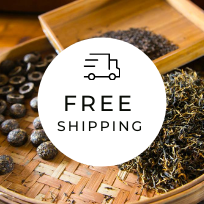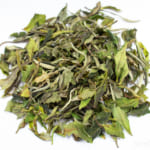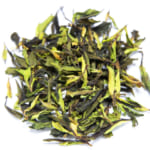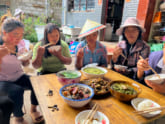- HOME >
- How to choose quality tea
The Summary of Yunnan Spring Tea 2017
As the season of the first plucking is over, I would like to share my review on 2017 teas from the South West of Yunnan, such as Lincang, Bao Shan, Jing Gu, Chang Ning and Da Li area.
Usually, the most critical factor that affects the quality of tea is weather. Since the day I came to Yunnan on 21st of March, I have been recording the weather and closely monitoring the tea quality accordingly.
- Early March〜31st March : Sunny and Cloudy
- 1st of April〜7th of April : Rain and Cloudy
- 8th of April〜14th of April:Sunny
- 14th of April〜 :Rain after Rain……..
The quality of Ming Qian(明前) tea is less attractive this year
Since the end of last year, it has been very dry weather in Yunnan. This unusual weather was not only taken place in Yunnan, but also happened in many other places in China and even Taiwan too.
Due to extremely little rain and continuous drought, the tea season delayed about 2-3 weeks. In normal year, starting from 25th of March, farmers in Lincang region start plucking tea. This year, we waited till April and we could hardly see the tea budding at the ideal garden. Those teas available before Qing Ming (清明) i.e., 4th of April, were collected from low elevation, very young tea tree or fertilized tea garden. Those teas from higher elevation, old tea tree and the naturally-farmed garden without fertilizer remained in very small bud; some trees were still dormant. As a result, tea plucked before April was not of good quality. Eventually we did not collect any tea before April, except Wild Tea that plucking season is always earlier than other tea.

Those young tea trees were available for plucking in early season.
The first week of April was raining
The rain started from 1st of April and continued for a whole week. The temperature dropped drastically and it was very cold. I had to wear the fleece jacket and run the heater when I stayed in the hotel room. Nevertheless, the rain at this timing was good news since tea trees had been suffered from drought for a long time. We assumed that it makes tea in excellent quality once the weather is sunny and temperature raise. The rain continued until 6th of April. From 7th of April, we noticed a lot of farmers effectively started tea plucking. We did not collect tea until the 9th of April. The reason is the quality of tea just after the rain is not ideal. Tea contains too high moisture and taste become thin and flavor is lighter. Those tea manufacturers who are very strict in quality will wait for two days after the rain to resume the tea plucking.
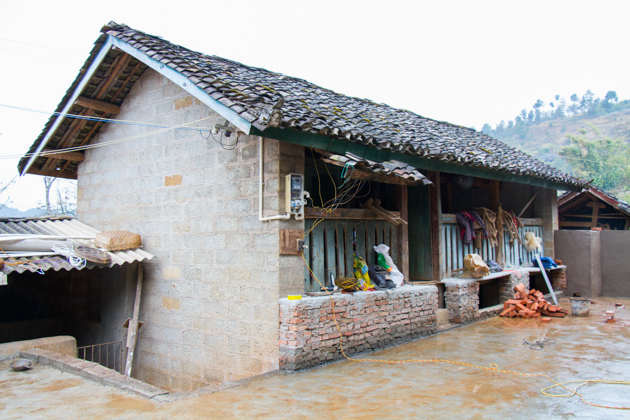

Only 30-50% of harvest
Unfortunately, the sunny weather only continues for a week. Despite people were so desperately waiting for the tea, the rain started again from 14th and continue. It was raining almost every day except certain places were sunny or cloudy on 23rd to 25th of April. Eventually raining continues until the end of April. Obviously farmers and tea manufacturers were panic due to extremely low output.
In Lincang, the production of tea is about 40-60% lower than regular year. In particular, teas from higher elevation, old tea tree and the naturally-farmed garden without fertilizer produce only 30-40% of output compared to regular year.
Due to extremely low output, the price of fresh tea leaf increases about 30-40%. For popular garden, the price increased 50% or even more.

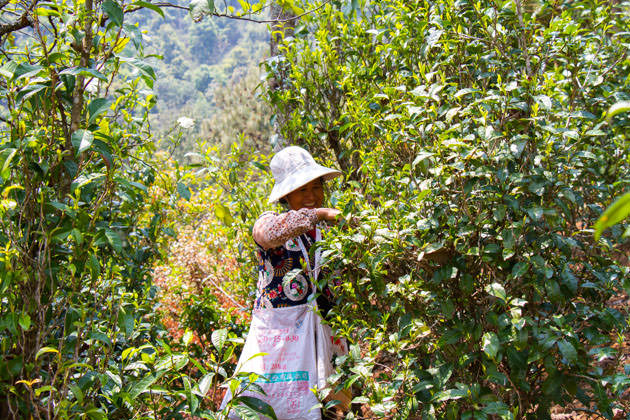
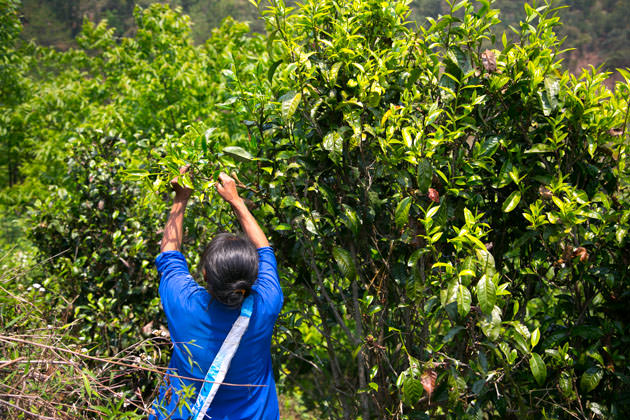
The best quality in the past 10 years
Due to the prolonged drought, the tea trees took much longer time to grow. I noticed that the quality of tea produced in the particular one week of sunny weather was extraordinarily outstanding. Most of the skilled and experienced tea masters generally realized that teas produced in this golden one week was the best quality in a past decade or even two decades. However, the good quality teas were only produced in a short period, i.e., from 9th until 13th of April. Any teas produced earlier or later are not satisfactory due to too much rain and cloudy weather. We purchased all pu-erh teas right from the golden week except for the wild tea that are usually grown earlier.

As the weather in the latter half of April was unexpectedly bad, those well-processed teas produced in the particular golden week were extremely limited and were in high demand. They were sold out even before out from the manufacturing site in the rural village. In 2017, some people may comment that the quality is outstanding, yet some people may comment that the quality is not very good. It is all depending on the timing and the sourcing ability of each company.
Related Articles
How to get the latest update on HOJO Tea?
1. Follow Twitter, 2. Click "Like" on Facebook, and 3. Subscribe in newsletter. You can have the latest tea news from HOJO Tea.
 Subscribe the Newsletter to enjoy the privileges
Subscribe the Newsletter to enjoy the privileges- You may receive a free sample upon purchase, or you may have the priority to purchase special products. So please remember to subscribe our newsletter as well as the social network.
- Yunnan Chun Jian Green Tea from High Mountain Gardens
- Yunnan Chun Jian Green Tea is now available.This tea is made from naturally grown leaves harvested from high mountain gardens at 2100m above sea level. It has a rich, long-lasting lingering aftertaste, comparable to raw Pu-erh tea. Yunnan as a Distinctive Tea Growing Region Over the past 20 years, we have explored a wide range …
- Limited Loose Leaf Release of 2025 Da Xue Shan Wild Raw Pu-erh Tea
- We have released the 2025 loose-leaf version of Da Xue Shan Wild Raw Pu-erh Tea.This tea comes from wild tea trees that grow naturally in the high mountains of Yunnan Province, at elevations above 2000 meters. This year, we were only able to secure a small quantity for retail, and the current release is available …
NEW ARTICLES
 Yunnan Chun Jian Green Tea from High Mountain Gardens
Yunnan Chun Jian Green Tea from High Mountain Gardens- Yunnan Chun Jian Green Tea is now available.This tea is made from naturally grown leaves harvested from high mountain gardens at 2100m above sea level. It has a rich, long-lasting lingering aftertaste, comparable to raw Pu-erh tea. Yunnan as a Distinctive Tea Growing Region Over the past 20 years, we have explored a wide range …
 Limited Loose Leaf Release of 2025 Da Xue Shan Wild Raw Pu-erh Tea
Limited Loose Leaf Release of 2025 Da Xue Shan Wild Raw Pu-erh Tea- We have released the 2025 loose-leaf version of Da Xue Shan Wild Raw Pu-erh Tea.This tea comes from wild tea trees that grow naturally in the high mountains of Yunnan Province, at elevations above 2000 meters. This year, we were only able to secure a small quantity for retail, and the current release is available …
 2025 Da Xue Shan Wild White Tea Now Available from Yunnan
2025 Da Xue Shan Wild White Tea Now Available from Yunnan- The 2025 harvest of Da Xue Shan Wild White Tea is now available. Crafted from truly wild Camellia taliensis trees growing naturally in the high-altitude forests of Yunnan, this tea offers a purity and character unique to its origin. This year’s unusually dry climate during the withering season was ideal, resulting in a floral and …
 Why Do Some Teas Taste Astringent? Exploring the Causes and Mechanisms of Astringency
Why Do Some Teas Taste Astringent? Exploring the Causes and Mechanisms of Astringency- Tea can range from having no noticeable astringency to possessing a very strong one. What causes this astringency? This article explores the causes and mechanisms behind astringency in tea. Causes of Astringency Astringency arises from the binding of tea components to proteins in the oral cavity, creating a sensation of tightness or dryness. The tongue …
 The Impact of Heat Sources on Tea Flavor
The Impact of Heat Sources on Tea Flavor- It is widely recognized that the material of a kettle plays an important role in shaping the taste of water for brewing tea. Yet, an often overlooked but equally significant factor is the type of heat source used to boil the water. Different heat sources, whether gas, electric, charcoal, or wood fire, can impart distinct …
 New Release of High Mountain White Tea
New Release of High Mountain White Tea- We are pleased to introduce our High Mountain White Tea, sourced from a unique tea garden with two key features: 1. Located at an altitude of 2200-2300m2. Completely wild and untended The ideal natural conditions of this garden result in tea of exceptional quality, offering a pure and gentle, nourishing taste. High Altitude and Wild …
 New Release of Da Xue Shan Wild White Tea 2024
New Release of Da Xue Shan Wild White Tea 2024- We have released the 2024 Da Xue Shan Wild White Tea Loose Leaf. This tea was produced under our direct supervision during our stay in Yunnan Province, ensuring meticulous production management on site. Definition of Wild Tea in Yunnan Province People in Yunnan strongly associate Camellia taliensis with wild tea, regardless of where it is …
 New Release of Wild Pu-erh Jasmine Pearl
New Release of Wild Pu-erh Jasmine Pearl- Out of curiosity, we decided to create a jasmine tea based on Da Xue Shan Wild Raw Tea. This resulted in an exceptionally rare tea, not only in Japan but also in China. Custom Production Network for Jasmine Tea At our store, we source various types of base teas from different regions during the spring. …
 2024 Overview: Our Yunnan White Tea Quality, Process, and Weather Insights
2024 Overview: Our Yunnan White Tea Quality, Process, and Weather Insights- One of the teas we’ve been focusing on in Yunnan Province is white tea. Historically white tea has been produced in both Fujian Province and Yunnan Province for a long time. While white tea from Fujian Province is well-managed during processing, we are dissatisfied with the quality of the raw materials due to the use …
 Yunnan’s Hospitality Culture: Expressed Through Meals
Yunnan’s Hospitality Culture: Expressed Through Meals- In China, as a form of greeting, it’s common to say “你吃饭了吗?” which means “Have you eaten?” However, in Yunnan Province, the phrase “吃饭” is often used in various situations, more like “Eat, eat,” serving as an invitation to share a meal. Yet, with prolonged exposure to Yunnan, one comes to understand that these meal …
Shop Info

Address:Lot No. T-215, 3rd Floor, The Gardens Mall, Mid Valley City, Lingkaran Syed Putra, 59200 Kuala Lumpur
Tel: +603-2287-4537
Business Hour: 10am to 10pm
Category
- New Arrival at HOJO Online Shop
- Featured Articles
- Newsletter
- Types of Tea
- Origin of Tea
- Teapot and Tea Equipment
- Tea Column
- How to enjoy tea
- Tea Processing
- How to choose quality tea
- Tea constituents and functional effect
- Safety of Tea
- Foods
- Tea Business Operation
- Hobby and Outdoor Activity
- Ranking of Tea
- Video
- FAQ
- Media Release
Profile

- AKIRA HOJO
- I invite you to experience my tea selections.I was born in Nagano, Japan. In university, I studied agricultural chemistry, and I have the master degree in food science. I worked in Japanese food industry for 10 years. I involved in R&D, QC and QA. As a factory manager, I implemented ISO9000 series and managed the factory.
- The Art of Tea Magazine
- We posted the article on “The Art of Tea Magazine No.9, the magazine is published in Taiwan. We featured some scientific view about the tetsubin
- New Straits Times
- The Malaysian National Newspaper, New Straits Times featured HOJO Tea on 17-Oct-2007.



